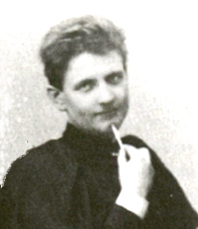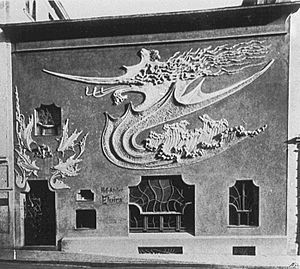Sophia Goudstikker facts for kids
Quick facts for kids
Sophia Goudstikker
|
|
|---|---|
 |
|
| Born |
In 1898 at Atelier Elvira
15 January 1865 Rotterdam, Netherlands
|
| Died | 20 March 1924 (aged 59) |
| Nationality | Dutch and German |
| Occupation | photographer, women's rights activist |
| Years active | 1889–1924 |
| Known for | first single woman to obtain a royal license for photography |
Sophia Goudstikker (born January 15, 1865 – died March 20, 1924) was a talented photographer and a pioneer for women's rights. Born in the Netherlands, she became a key figure in Germany, especially in Munich. She worked closely with other women who wanted to improve life for women.
Sophia was known for her unique style, which inspired writers to create characters based on her. She was also the first single woman in Germany to get a special license for photography from the royal family. Later, she became the first German woman allowed to speak in youth court cases.
Contents
Early Life and Education
Sophia Goudstikker was born on January 15, 1865, in Rotterdam, Netherlands. Her parents were Grietje and Salomon Elias Goudstikker. In 1867, her family moved to Hamburg, Germany.
Later, they moved to Dresden, where Sophia attended an art school. At this school, she met Anita Augspurg, whose sister ran the art school. Sophia and Anita became friends and decided to start a business together. They thought Munich would be a good place for a women-run business.
Photography Career and Women's Rights
In 1887, Sophia Goudstikker and Anita Augspurg moved to Munich. There, they opened a photography studio called Hofatelier Elvira. Sophia was the first unmarried woman in Germany to receive a special royal license for photography.
Their studio quickly became a popular spot for artists and thinkers. Many famous people visited to have their pictures taken. These included dancer Isadora Duncan, Grand Duchess Marie-Adélaïde, Grand Duchess of Luxembourg, and poet Rainer Maria Rilke.
In 1898, Sophia and Anita decided to go their separate ways. Sophia continued to run the studio by herself until 1908. She hired the architect August Endell to design a new, famous building for the studio. Its unique turquoise and violet front with a dragon design made it a landmark. Sophia's younger sister, Nora, also worked with her as a photographer.
Fighting for Women's Rights
As their photography business grew, Sophia and Anita became strong supporters of women's rights. They wanted to change how society viewed women's roles. Sophia often wore short hair and simple clothes, which was unusual for women at the time. Her style inspired writers to create characters who were strong and defied traditional ideas of femininity.
In 1889, Sophia and Anita joined a movement to allow women to study at universities. The next year, they joined the Modern Life Society. This group aimed to bring modern ideas into social and artistic areas for women. Police often watched their meetings, thinking they were promoting bad behavior or political protests. Sophia's job was to convince the authorities that their meetings were not political.
In May 1894, Sophia and Anita founded the Society for Women's Interests (Vereins für Fraueninteressen). This group worked to expand women's organizations into economic and legal areas. Ika Freudenberg, another important feminist, helped start this group and managed it for many years.
After Sophia and Anita's business partnership ended, Sophia focused more on practical women's issues. She worked on achieving equal economic and legal rights for women. From 1898 until her death, she led the legal protection office of the Society for Women's Interests.
Sophia Goudstikker became the first German woman allowed to represent cases in youth courts. She did not have a law degree, but her skill in defending young people earned her much respect in Munich. Sophia and Ika Freudenberg lived together in a building behind the studio. Sophia passed away in Munich on March 20, 1924.
Sophia's Lasting Impact
Sophia Goudstikker's life and work have inspired many people. She helped redefine what women could achieve in society. Her unique personal style and strong will encouraged writers to create characters that broke away from typical female roles.
Today, a park in Munich Ramersdorf is named after her, honoring her contributions to women's rights and her impact on the city.


